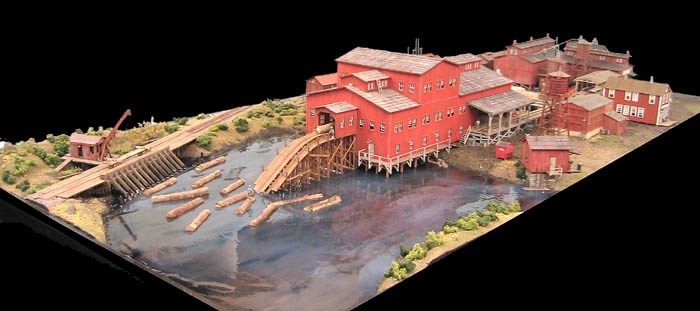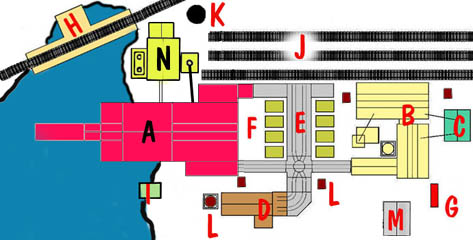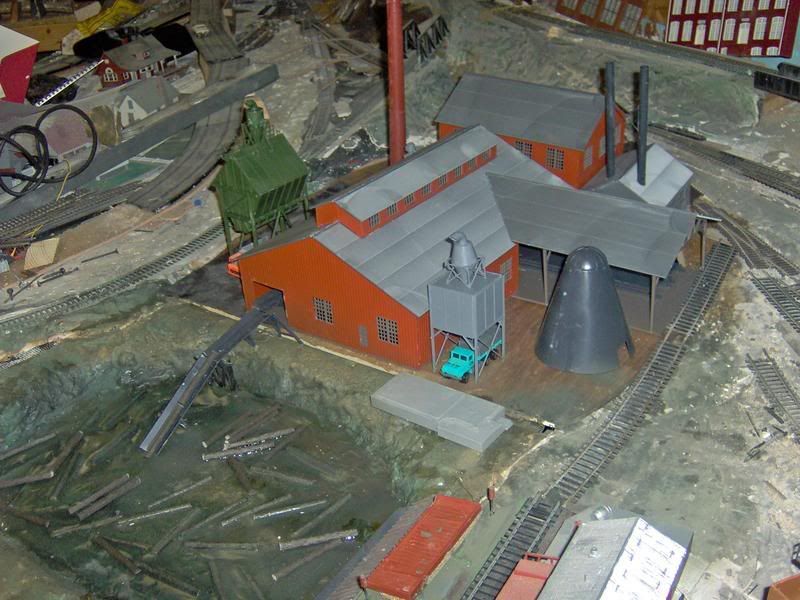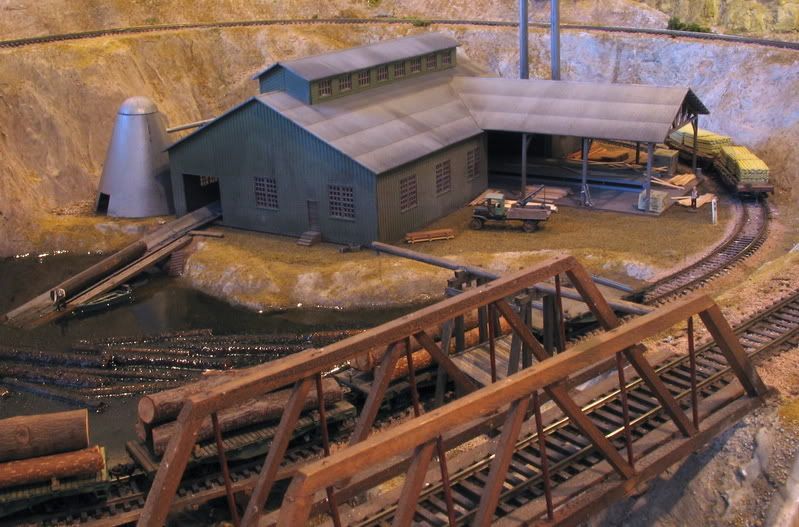Does anyone have photos or designs of how lumber mills and pond would be situated next to track…
http://images.google.com/images?gbv=2&hl=en&q=lumber+mill+ponds
http://images.google.com/images?gbv=2&hl=en&q=lumber+mills&btnG=Search+Images
Model of BTS Slatyfork Sawmill.



Chip, is that your modelling work?
That’s amazing [wow]
No. I took that off the BTS site. (Thanks for the thought)
This is a link to their site telling what each of the buildings are
http://www.btsrr.com/millplan.htm
Have fun
Great link there from Loathar, and there are dozens of good books about logging railroads to use as resources. Here’s a photo of the mill at Cass, WV.

Bill
Here is what I did … Walthers lumber mill w/scratchbuilt log dumps …

Looks very good!
Just curious since logging railroads is a subject I know next to nothing about:
You seem to have two places to dump logs - one in the foreground of the picture (by the loaded log car), and one on a separate spur in the distance.
So how do you operate when dumping logs here ? Looking at the picture and gGuessing, I would think that you maybe back a log train down the siding towards us, dump logs from the rearmost three-four cars at the nearest log dump, leave those empty cars cars on the siding temporarily, and then pull ahead before backing into the other log dump to dump the logs on the other 2-3 cars there.
Or do you do this some other way ? What happens with the emptied log cars - sent back to logging camps right away to pick up more lumber ?
What does the rest of the scene look like ? Got a picture from further to the left that shows more of the lumber mill and the loading area ? Or a track plan ?
And what are those interesting log-like things sticking out in the air above the two log dump areas ?
Smile,
Stein, curious
Stein,
I don’t recognize those structures near the log dump as anything I’ve seen before, but it looks like a very inexpensive way to pull the logs off the cars.
There are two log dumps in the pond to increase efficiency. They are separated so that the logs don’t foul each other.
I’ve done a little research on logging and have a few books. I don’t recall seeing two log dumps on a single track separated like that, not to say it may not have been done. What I see here is a dual use of the log dump track. It is also used to load finished cut lumber from the mill. By using the track this way with only one log dump, a long incoming log train would be too long to be able to get the logs off of all the cars without encroaching on the finished loading process. I think Oakhurst did a good job of figuring out how to do it in a limited space. Very creative. However, the horizontal beams, poles, or whatever on top of or over the log dump equipment is a bit of a mystery to me as well.
OK, looking closer, the ends of the poles toward the pond could be cable attachments. The dumping cable would go from the pole ends, back over top of the logs on the car away from the pond, then under the logs on the car toward the pond, through a pulley and back under the track into the winch house. When the cable is pulled tight, it forces the logs off of the cars where they slide into the pond.
My stationary and winching points could be reversed. Maybe the cable was winched into the house from the rear of the boom, and a hook was fastened to the edge of the log dump ramp. That would make the ends of the boom toward the pond have pulleys for the cable. But each time a log car came up to the dump point, a man would have to take the cable over the top, and then under the log load. So yea, it now makes more sense that the stationary point of the cable is on the top of the log dump ramp.
Edit:
Every time I look at Oakhurst’s photo, I see something different. I have now noticed that he is using the same type of cars for his log loads as his outgoing cut lumber loads. So it is possible that the same cars that come from the woods with logs, could be shoved up to the cut lumber loading point after dumping logs.
This is a view of the Walther’s lumber mill on my layout. The (unfinished) railroad spur will come down the right side to dump logs, or to pick up finished lumber. The unique thing about this lumber mill. is that the entire diorama (up to the spur) is mounted on a pullout drawer (for easy access to the tracks in the rear). Full, or empty log cars are stored on the spurs to the right. The “Magic Water” has a tendency to creep up on the logs and pond bank. Joe Fugate’s Video Vol.#5 (which I just got today) shows how to prevent the plastic water creep

Here’s another sawmill for the thread…

From the Great Northern Pacific Railroad, Austin TX. Owned by Chuck Ellis. Photo taken by me.
Don Z.
Now those are some logs.
You guys have done quite a bit of thinking about my arrangement. Here is what the area to the right looks like, showing the rest of the lumber mill. This photo is a little older and shows fewer bushes and scrubs than are present now.

The spur track continues down past the mill and 2 flat or box cars are used for the cut lumber loads. I’m not completely happy with the lumber loading area, as it should really have an elevated dock to make loading the lumber easy. Couldn’t figure out how to do that easily.
For operations, I usually push 5 loaded log cars down the spur track, ignoring the short siding to the 1st log dump and use the 2nd log dump on the long track. If I have more than 5 cars, the last won’t get in position before running into the 2 lumber cars at the end of the track. So, I have to use the short (3 car) siding at the first log dump for switching. I sort of figured that the first (and short siding) log dump might be abandoned.
Here is the inspiration for the log dump structures:

On the prototype, they were rebuilt several times over the years and they were fairly unusual, but log dumps of this type were used on the Madera Sugar Pine Railroad. You can’t see the wire/cable very well in the pictures, but the winch house is connected to a series of wheels and pulleys out to the end of the near horizontal pole. The cable is then looped back around the log load and hooked back upon itself. Then the winch goes and pulls the logs out toward the ramp and pond. This often caused derailments which had to be quickly fixed. Must of been something to see!
I hope this helps understand what went into planning this scene, as it is very space limited, being an “island” into the middle of my 8.5 x 11
Very nice! Thank you for sharing these photos and the description of how you operate your layout! This stuff is fascinating.
Smile,
Stein
http://www.garymkatz.com/OnTheRoad/HullOaks.htm could be useful although it is about 6 MB due to the pictures.
Some general material
http://railroad-line.com/discussion/topic.asp?ARCHIVE=true&TOPIC_ID=8629
http://www.lauriegreen.info/Driwrott%202/driwrott2.html
http://www.lauriegreen.info/Driwrott%203/driwrott3.html
Cheers
Peter C
Australia
Great helps guys… I’m definatly getting it now… And now I think I know how I’m going to get my scene how it I wany iy. Thanks again
Mike
I ran across some excellent rescorces.
http://www.freerails.com/view_topic.php?id=239&forum_id=3
Scroll down to “logging” and “sawmills” There’s some really great links in this list.
Great link… Thanks
Mike